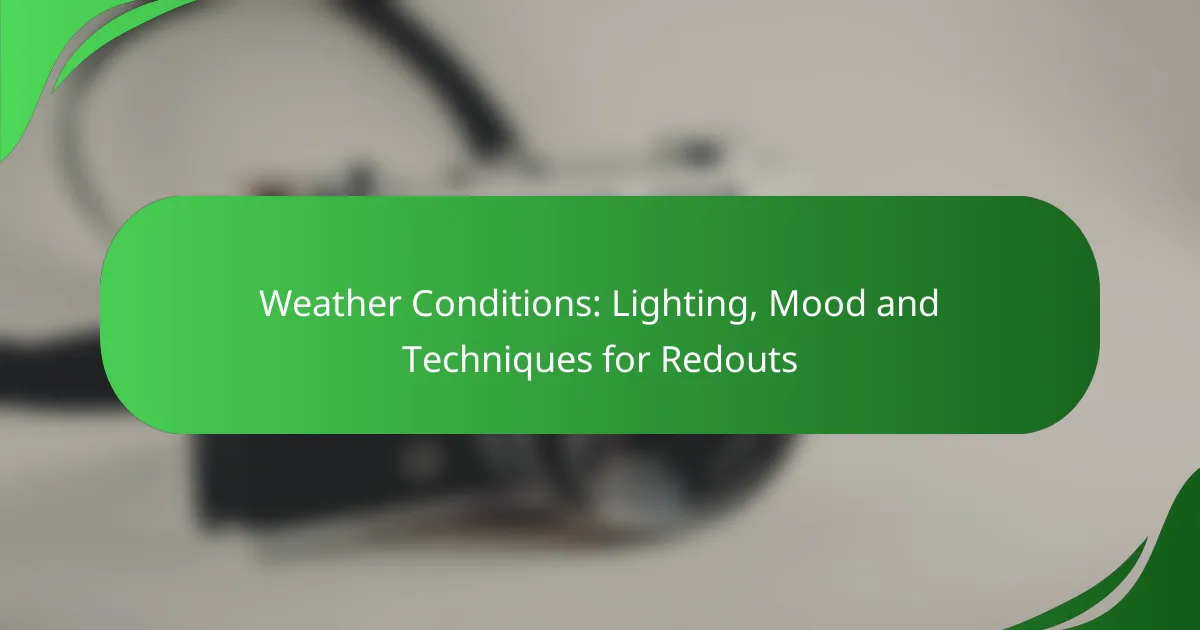Weather conditions play a pivotal role in determining the lighting and mood of photography, offering unique atmospheres that can enhance the visual narrative. In challenging scenarios like redouts, employing techniques such as reflectors and diffusers, along with careful camera adjustments, can significantly improve image quality. Understanding how various lighting influences colors and contrasts allows photographers to create more impactful and emotionally engaging images.
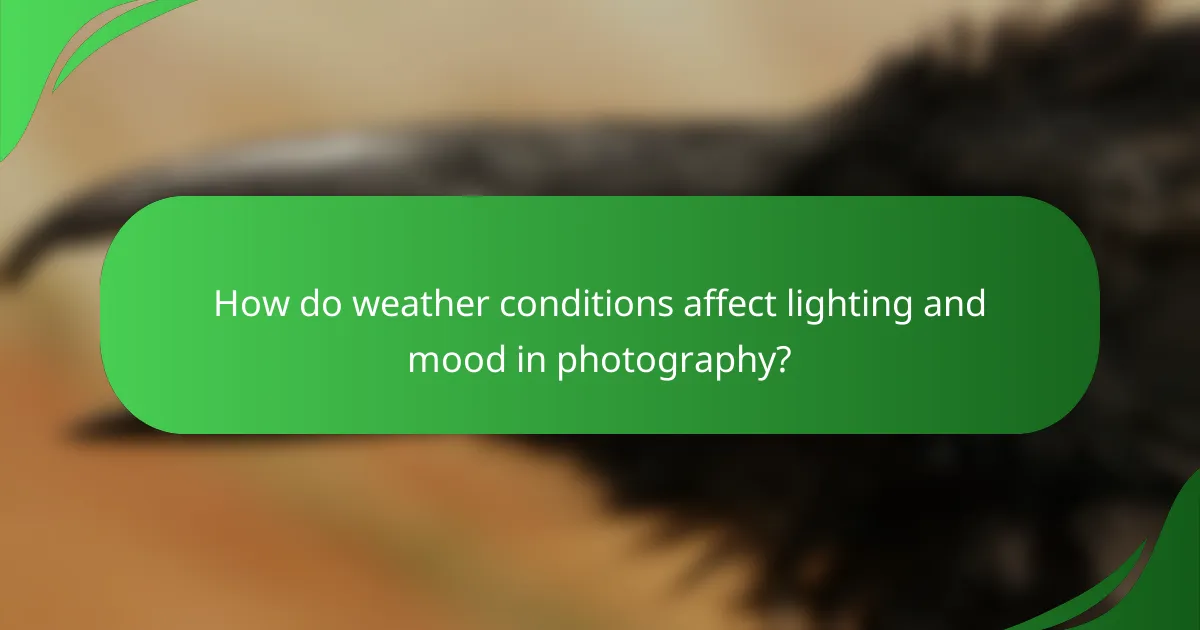
How do weather conditions affect lighting and mood in photography?
Weather conditions significantly influence lighting and mood in photography, shaping the overall aesthetic of images. Different weather scenarios create unique atmospheres that can enhance or detract from the subject being captured.
Bright sunny days enhance colors
On bright sunny days, the abundant natural light intensifies colors, making them appear more vibrant and saturated. This is particularly beneficial for outdoor photography, as subjects like flowers, landscapes, and architecture can be showcased in their most vivid form.
However, harsh sunlight can also create strong shadows and highlights, which may lead to loss of detail in certain areas. To mitigate this, consider shooting during the golden hour—shortly after sunrise or before sunset—when the light is softer and more flattering.
Overcast skies create soft shadows
Overcast skies provide diffused light that softens shadows and reduces contrast, resulting in a more even exposure. This type of lighting is ideal for portrait photography, as it minimizes harsh lines and creates a gentle, flattering effect on skin tones.
Additionally, the muted colors on overcast days can evoke a calm and serene mood, making it suitable for capturing intimate or reflective moments. Photographers should embrace this lighting by focusing on details and textures that might be overlooked in brighter conditions.
Rainy weather adds a moody atmosphere
Rainy weather introduces a unique, moody atmosphere that can enhance storytelling in photography. The wet surfaces reflect light differently, creating interesting textures and depth in images. Rain can also add a sense of drama and emotion, making it a powerful element in narrative photography.
When shooting in the rain, consider using a waterproof camera cover to protect your equipment. Look for opportunities to capture reflections in puddles or the way raindrops interact with your subject, as these elements can add a dynamic quality to your photos.
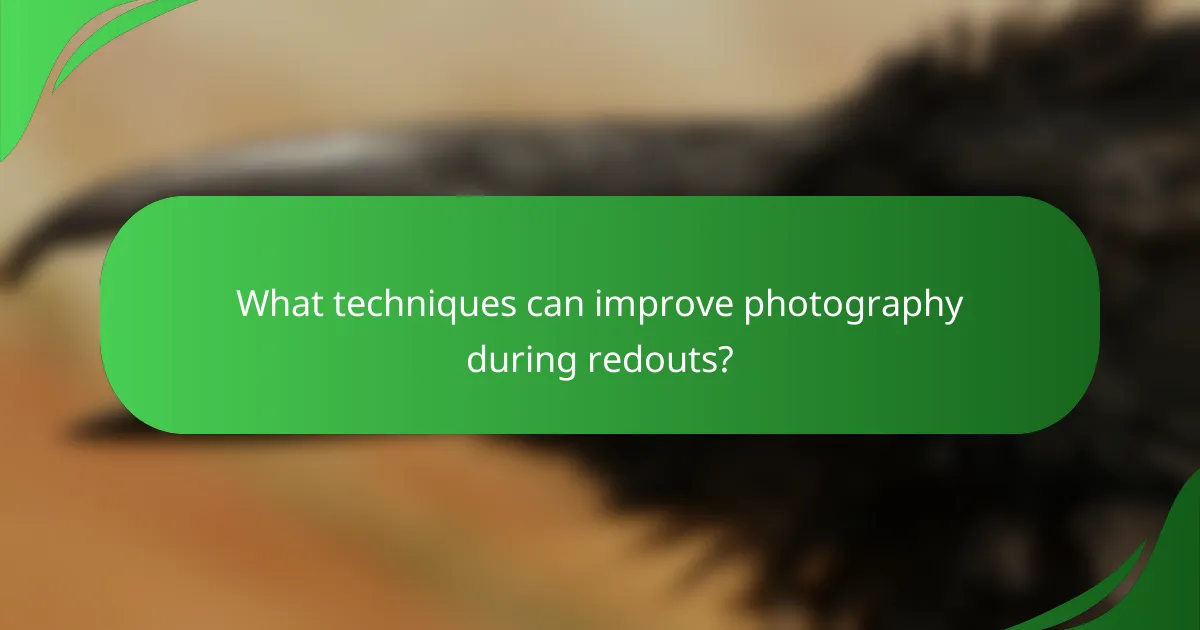
What techniques can improve photography during redouts?
To enhance photography during redouts, utilize reflectors, diffusers, and adjust camera settings. These techniques help manage light effectively, ensuring better image quality even in challenging conditions.
Use reflectors to bounce light
Reflectors are essential tools for redirecting available light onto your subject, especially during redouts when natural light may be limited. By positioning a reflector opposite your light source, you can fill in shadows and create a more balanced exposure.
Common materials for reflectors include white foam boards, silver or gold surfaces, which can add warmth or coolness to your images. Experiment with different angles and distances to find the most flattering light for your subject.
Employ diffusers for softer light
Diffusers help soften harsh light, reducing contrast and creating a more pleasing atmosphere in your photographs. When using a diffuser, place it between the light source and your subject to scatter the light evenly.
Materials like translucent fabric or specialized diffusion panels work well. This technique is particularly effective in outdoor settings during bright conditions, where direct sunlight can create unflattering shadows.
Adjust camera settings for low light
In redout conditions, adjusting your camera settings is crucial for capturing clear images. Increase the ISO setting to enhance sensitivity to light, but be mindful of potential noise in your photos.
Additionally, consider lowering the shutter speed to allow more light to hit the sensor, but use a tripod to avoid motion blur. A wide aperture can also help, as it lets in more light and creates a shallow depth of field, isolating your subject effectively.

How can lighting techniques enhance mood in outdoor photography?
Lighting techniques play a crucial role in shaping the mood of outdoor photography by influencing colors, contrasts, and overall atmosphere. By understanding how different lighting conditions affect your images, you can create more compelling and emotionally resonant photographs.
Golden hour provides warm tones
The golden hour, occurring shortly after sunrise and before sunset, offers soft, warm light that enhances colors and creates a pleasing atmosphere. This lighting condition is ideal for capturing landscapes and portraits, as it adds a natural glow to subjects.
To make the most of golden hour, plan your shoots around these times. The light typically lasts for about an hour, so arrive early to set up and scout your location. Aim to shoot within the first 30 minutes for the best results.
Backlighting creates silhouettes
Backlighting occurs when the light source is behind the subject, resulting in striking silhouettes. This technique can add drama and intrigue to your compositions, emphasizing shapes and outlines while minimizing distracting details.
To effectively use backlighting, position your subject between the camera and the light source, ensuring the light shines through or around them. Experiment with different angles to find the most impactful silhouette, and consider using a wide aperture to create a soft background blur.
Using artificial lights adds drama
In outdoor photography, artificial lights can dramatically enhance your images by introducing controlled lighting elements. Techniques such as using flash or portable LED lights can help highlight specific areas or subjects, adding depth and interest.
When using artificial lights, consider the color temperature to ensure it complements the natural light. For instance, using a warmer light can create a cohesive look during golden hour, while cooler lights can add contrast during midday. Be mindful of the intensity and direction of the artificial light to avoid harsh shadows or overexposure.
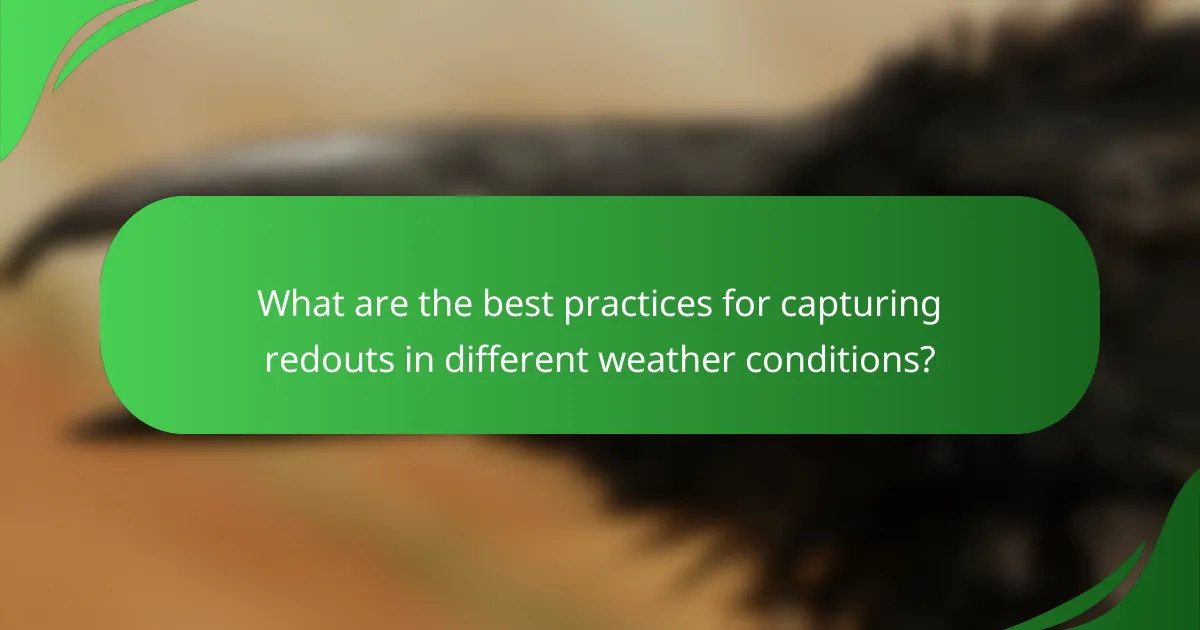
What are the best practices for capturing redouts in different weather conditions?
To effectively capture redouts in varying weather conditions, it’s crucial to plan ahead and adapt your techniques based on the forecast. Understanding how light interacts with weather elements can significantly enhance your photography results.
Plan shoots around weather forecasts
Checking weather forecasts is essential for planning your photography sessions. Ideal conditions for capturing redouts often include overcast skies or moments just before a storm, where the light can create dramatic effects. Aim to shoot during the golden hour, which typically occurs shortly after sunrise or before sunset, for softer lighting.
Be flexible with your schedule; sometimes, the best opportunities arise unexpectedly. If forecasts predict changing conditions, be ready to adjust your plans accordingly to seize the moment.
Utilize weather apps for real-time updates
Weather apps can provide real-time updates that are invaluable for photographers. Use apps that offer detailed radar images and alerts for sudden changes, such as incoming storms or shifts in cloud cover. This information can help you decide when to head out for a shoot or when to wait for better conditions.
Some popular weather apps include The Weather Channel, AccuWeather, and Dark Sky. Make sure to familiarize yourself with their features to maximize your shooting opportunities.
Experiment with different angles and compositions
When capturing redouts, varying your angles and compositions can lead to unique and striking images. Try shooting from low angles to emphasize the sky’s colors or from higher vantage points to capture the landscape beneath the redout. Each perspective can convey a different mood and story.
Additionally, consider using foreground elements to frame your shots. This technique can add depth and context, making your images more engaging. Don’t hesitate to take multiple shots from different positions to find the most compelling composition.

What equipment is essential for photographing in adverse weather?
To effectively photograph in adverse weather conditions, essential equipment includes waterproof camera gear, lens hoods, and sturdy tripods. These tools help protect your gear, improve image quality, and maintain stability in challenging environments.
Waterproof camera gear
Using waterproof camera gear is crucial when shooting in rain, snow, or high humidity. This equipment is designed to prevent moisture from damaging internal components, ensuring your camera functions properly in wet conditions. Look for cameras with weather-sealing or invest in protective covers for added security.
Consider lenses that are also weather-resistant, as moisture can easily seep through any openings. If you frequently shoot in adverse conditions, investing in a fully waterproof camera system can save you from costly repairs.
Lens hoods to reduce glare
Lens hoods are essential for minimizing glare and lens flare caused by reflections from wet surfaces or bright light. By blocking stray light, they help maintain contrast and color saturation in your images. Choose a lens hood that fits your specific lens model for optimal performance.
In addition to reducing glare, lens hoods provide some protection against rain and snow, acting as a barrier that keeps moisture off the lens surface. Always keep a lens hood attached when shooting outdoors in adverse weather to enhance image quality.
Tripods for stability in wind
Using a sturdy tripod is vital for maintaining stability during windy conditions, which can lead to blurry images. Look for tripods made from durable materials that can withstand strong gusts without tipping over. A heavier tripod can provide better stability, but consider portability if you need to move frequently.
To further enhance stability, use a tripod with a hook for adding weight, such as a camera bag or sandbag. This additional weight can help anchor the tripod in windy conditions, ensuring sharper images and reducing the risk of camera shake.
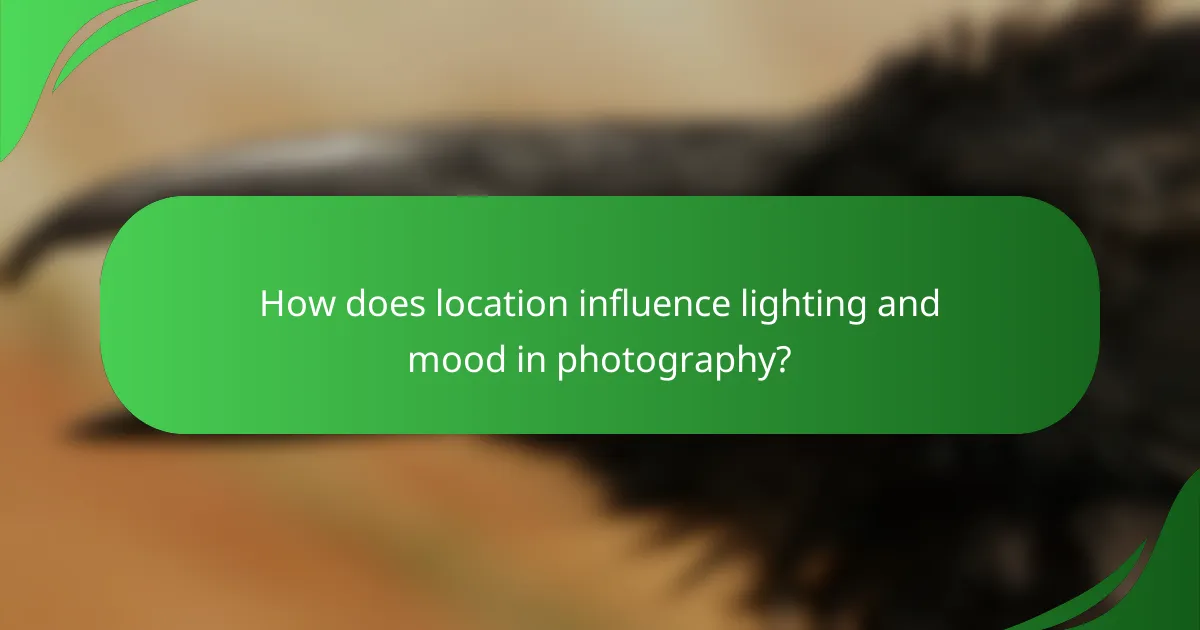
How does location influence lighting and mood in photography?
Location significantly affects lighting and mood in photography by determining the type and quality of light available. Urban environments often feature artificial lighting, while natural landscapes provide a range of natural light conditions that can evoke different emotions.
Urban settings reflect artificial light
In urban photography, artificial light sources such as street lamps, neon signs, and building lights dominate the scene. These lights can create dramatic contrasts and vibrant colors, enhancing the mood of the photograph. For instance, shooting at dusk can yield rich blues and warm yellows, making the city feel alive.
When capturing urban scenes, consider the time of day and the direction of light. Nighttime photography can emphasize reflections and shadows, while golden hour can soften harsh edges. Experimenting with exposure settings can help balance the bright artificial lights with darker surroundings.
Natural landscapes offer varied lighting
Natural landscapes present a diverse array of lighting conditions influenced by the time of day, weather, and geographic features. Early morning and late afternoon light, often referred to as golden hour, casts a warm glow that enhances colors and textures in nature. Overcast days provide diffused light, which can soften shadows and create a moody atmosphere.
When photographing landscapes, pay attention to how natural light interacts with the environment. Use foreground elements to frame your subject and consider the impact of clouds or fog on the overall mood. Adjusting your shooting angle can also help capture the best light and create a more compelling composition.
